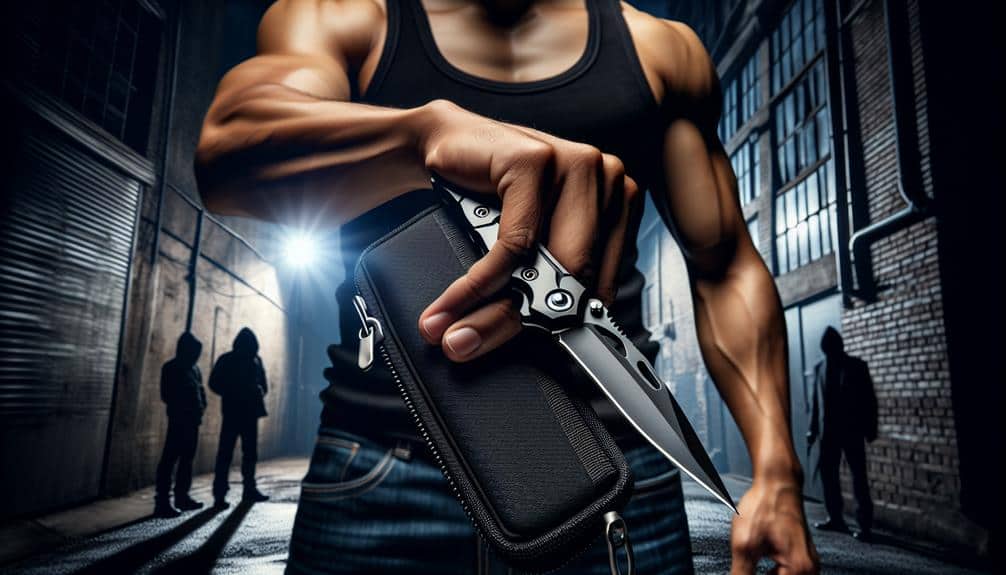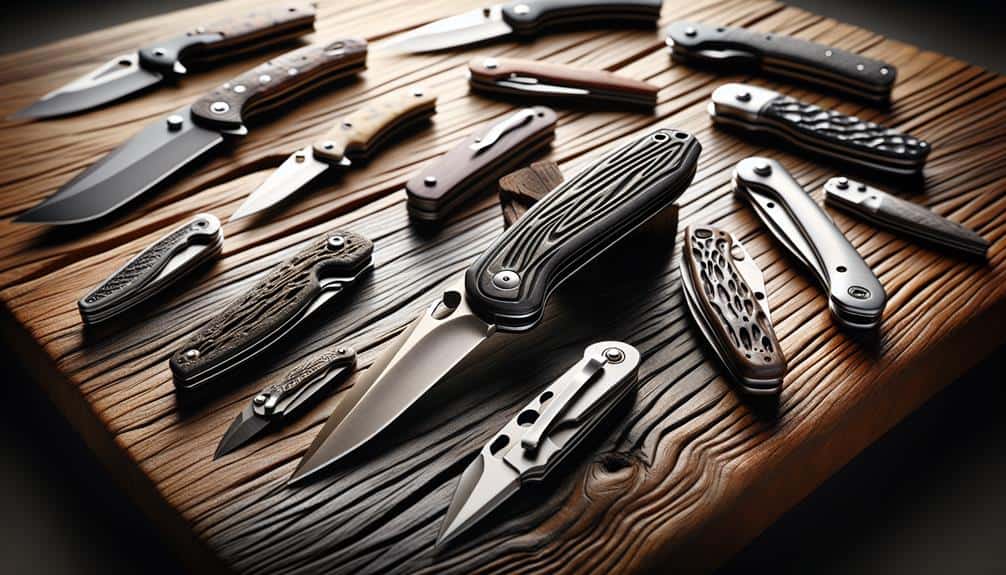Cutting-Edge Protection: How to Use a Pen Knife for Self Defense Like a Pro

Feeling like James Bond with a pen knife can be a real game-changer in self-defense! Start by picking a discreet, easy-to-carry pen knife—lightweight and compact is key. Grip it firmly between your index and middle fingers, blade outwards, while your thumb guides for control. Imagine yourself in a movie, angling slightly towards your opponent, ready to block and strike. Quick footwork and maintaining a good distance are essential. Practicing different grips and foot maneuvers builds muscle memory, making your reactions sharper. And hey, there’s a whole lot more on mastering this nifty tool just around the corner!
Choosing the Right Pen Knife

When choosing the right pen knife for self-defense, you should prioritize ease of carry and concealment by considering its size and weight. A lightweight and compact pen knife is a good thing because it’s not going to weigh you down or be a hassle to carry around. You’re going to make smarter choices when you focus on these factors, ensuring you have a reliable tool that’s easy to access when you need it most.
Next, you’ll want to look for a pen knife with a sturdy clip. This clip is going to secure the knife to your clothing or bag, meaning it’s always within reach. You don’t want to fumble around in a critical moment, right? So, a strong clip is definitely a must-have.
Then, consider the blade material. Opt for something durable like stainless steel. You’re going to learn that a good blade stays sharp and won’t rust easily, providing long-lasting reliability.
Proper Grip Techniques
To hold a pen knife properly, place it between your index and middle fingers with the blade facing outward, ensuring your thumb is firmly positioned to provide stability.
This grip will give you the control and precision you need during a self-defense situation, allowing for quick and effective movements.
Practice different grips, like reverse and forward, so you’re prepared for any angle of attack.
Optimal Finger Placement
Proper finger placement on a pen knife involves using a firm yet flexible grip with your thumb and index finger to guarantee better control and maneuverability. You’re going to need to go beyond just holding the knife; you need to master the technique.
Place your thumb on the spine of the blade and your index finger on the opposite side. This setup guarantees you can maneuver the knife with precision and quickness, which is crucial in a self-defense scenario.
Now, don’t grip the pen knife too tightly. Why? Because if you do, your hand will tire quickly, and you’ll lose the flexibility needed for defensive movements. Think of it like holding a pencil when you’re sketching a masterpiece—you need control, but also fluidity.
A balanced grip allows you to deploy the blade swiftly and target essential areas accurately. Training is essential here. Practicing the right finger placement will make your movements second nature, ensuring you’re both effective and safe when things get dicey.
Thumb Position Importance
Utilizing ideal finger placement, let’s concentrate on why the thumb’s position is important for maintaining control and precision during self-defense with a pen knife.
You mightn’t realize it, but thumb control can make or break your defense. When your thumb is properly placed on the spine of the pen knife, it enhances stability and leverage, allowing you to deliver effective strikes with confidence.
Imagine you’re in a tense situation: your thumb’s guidance guarantees precision targeting, giving you the ability to aim for critical areas accurately. This isn’t just about hitting your mark but doing so with the utmost control and finesse.
Here’s why thumb positioning matters:
- Thumb Control: It stabilizes your grip, giving you more leverage and balance in each move.
- Precision Targeting: Your thumb helps guide the blade, ensuring your strikes are accurate and effective.
- Effective Strikes: With your thumb in the right place, your attacks are more powerful and controlled, making every move count.
Firm Hand Control
Mastering a firm hand control with proper grip techniques is vital for maximizing the effectiveness of a pen knife in self-defense situations. To start, focus on your grip strength. A firm grip is your best friend, giving you stability and control. Think of it as the foundation of your defensive strategy. Without it, your pen knife might as well be a butter knife.
When holding the knife, your hand control is essential. You want a closed grip, fingers wrapped tightly around the handle. This guarantees you’re ready for any move. But don’t forget the thumb grip! Positioning your thumb on the back of the blade can give you precision and accuracy, making your defensive tactics more effective.
Sometimes, you need versatility. Switching to an open grip allows for quick deployment and maneuverability, adapting to different scenarios. Imagine needing to fend off an attacker; the ability to switch grips could be your ticket to safety.
Maintaining that firm hand control throughout every maneuver is key. It’s all about self-protection and being confident in your actions.
Basic Defensive Maneuvers

Speed and precision are essential when practicing basic defensive maneuvers with a pen knife. You need to be quick and accurate to effectively neutralize any threats. Let’s delve into some fundamental pen knife techniques and defensive strategies that will get you started.
First, the Box pattern moves are essential. Picture drawing a box in the air with your pen knife. This technique helps you cover different angles and keep the attacker at bay. Remember, speed and precision are your best friends here.
Second, the block trap technique is a lifesaver. When the attacker strikes, use your pen knife to block the attack and then trap their arm. This quick move can give you the upper hand in a tight situation.
Lastly, incorporate some stabbing techniques. A quick stab to vulnerable areas like the thigh or shoulder can create an opportunity for you to escape. Just remember to practice these moves regularly.
Here’s a quick recap:
- Box pattern moves: Cover all angles.
- Block trap technique: Block and trap the attacker’s arm.
- Stabbing techniques: Aim for vulnerable areas.
Master these basics, and you’ll be well on your way to becoming a pen knife pro!
Advanced Self-Defense Skills
When you’re ready to take your pen knife skills to the next level, it’s all about mastering precision striking techniques and perfecting your defensive stance.
Imagine moving like a shadow, quick and elusive, with each strike hitting its mark.
You’ll need to train hard, but the confidence and control you’ll gain are absolutely worth it.
Precision Striking Techniques
In high-stress situations, focusing on important areas like the eyes, throat, and groin can make your pen knife strikes incredibly effective.
First, let’s talk about target identification. Knowing where to strike is half the battle. The eyes can blind, the throat can choke, and the groin can incapacitate, allowing you to escape or call for help.
To get those strikes perfect, you need to practice speed drills. Quick, repetitive movements train your muscles to react without hesitation. Remember, speed is your ally when you’re defending yourself with a pen knife. Try these drills daily to build muscle memory.
Next, let’s do an impact evaluation. After you practice, evaluate how well you’re targeting those important areas. Did you hit the mark? Were your strikes fast and precise? Evaluating your impact helps you improve and ensures your strikes will count when it matters most.
Here’s a quick breakdown:
- Target Identification: Know the vulnerable areas.
- Speed Drills: Practice makes perfect.
- Impact Evaluation: Evaluate your effectiveness.
Keep your strikes sharp, quick, and on target. Combining these techniques will help you turn your pen knife into a powerful self-defense tool. Stay safe!
Defensive Stance Mastery
Mastering your defensive stance is vital for turning a pen knife into an effective self-defense tool. Imagine this: you’re in a tense situation, and your survival might depend on how well you hold your ground. Stance adjustments are your first line of defense.
Keep your dominant hand, gripping the pen knife, close to your body. Your non-dominant hand should be ready to block any incoming threats.
Body positioning is essential. Angle yourself slightly to the opponent, making it harder for them to reach you. Your front foot should point towards them, giving you the agility needed for quick strikes and effective counter attacks.
Always watch for visual cues from your opponent to predict their next move. This will sharpen your reaction time, making you quicker and more efficient.
Distance management is key. Keep just enough space to maneuver but close enough to strike when necessary. Move smoothly between offensive and defensive actions, always keeping the pen knife near your centerline. This way, you can defend and attack without wasting precious seconds.
Understanding the Box Pattern

The Box pattern in knife defense consists of five fundamental moves that you’ll need to master for effective self-defense. Each move has a specific purpose, helping you counter attacks and keep some distance between you and an attacker. But, to really nail it, you’ve got to work on your defensive footwork, angle adjustments, and defensive flow to stay swift and agile.
Now, let’s break down the essentials. Picture the Box pattern as a sequence of steps that flow together seamlessly. Here are the key components:
- Defensive footwork: Your feet are your foundation. You need to be able to move quickly and maintain your balance. Practice shifting your weight smoothly from one foot to the other.
- Angle adjustments: This is all about changing your position to avoid an attack. By shifting your angle, you make it harder for your opponent to land a hit.
- Defensive flow: Moving from one defensive move to the next should be fluid. Think of it like a dance where each step naturally leads to the next.
Practicing the Box pattern helps build muscle memory, making your reactions quicker and more instinctive in real-life situations. So, grab your pen knife, and get moving!
Implementing the Block Trap
Building on your understanding of the Box pattern, let’s explore the block trap technique to further enhance your self-defense skills with a pen knife. Imagine your opponent lunging at you. You intercept their attack with your forearm, trapping their arm—boom, you’ve just executed a block trap. Timing secrets are essential here; you need to nail the exact moment to redirect their momentum and gain arm control.
This isn’t just about defense. By controlling their arm, you create defensive openings and set up perfect counterattack strategies. Think of it like a chess match—you’re always a step ahead. To pull this off, you need a keen opponent understanding. Know their moves and how to throw them off balance.
Here’s a quick rundown to keep you on track:
| Key Elements | Description |
|---|---|
| Timing secrets | Precision in intercepting the attack |
| Arm control | Trapping and controlling opponent’s arm |
| Momentum redirection | Using opponent’s force against them |
| Counterattack strategies | Creating openings for follow-up moves |
Mastering the block trap will supercharge your close-quarters combat skills, turning you from a defensive turtle into a counterattacking hawk. So, why not give it a try and see just how powerful this technique can be?
Practicing for Real-World Scenarios

Practicing for real-world scenarios means simulating common attack angles and movements to prepare for genuine self-defense situations. You’ve gotta practice under stress to mimic that adrenaline rush you’d feel in a real fight. Think of it like a dress rehearsal, but with higher stakes.
One of the keys is improving reaction time. Quick reflexes can make all the difference when someone’s charging at you. Get a training partner, mix up the attack styles and intensities, and you’ll be ready for anything. Also, enhancing situational awareness is essential. Train in tight spaces or around obstacles to get used to dealing with real-world environments. Knowing your surroundings can give you an edge.
For effective counterattacks, imagine scenarios where you have to make split-second decisions. Here’s a quick rundown to help you practice:
- Quick Decision-Making: Set up drills where you have to react instantly to different attacks.
- Adapting to Circumstances: Change up your environment regularly to keep things unpredictable.
- Stress Drills: Simulate high-pressure situations to build nerve and resilience.
Frequently Asked Questions
Can You Use a Pen for Self-Defense?
Yes, you can use a pen for self-defense. It’s a discreet, everyday carry item that, with proper self-defense techniques, can serve as an improvised weapon. Training is essential to maximize its effectiveness in emergencies.
What Is the Best Knife Point for Self-Defense?
The best knife point for self-defense is either a Tanto or Clip Point. These blade shapes offer excellent penetration capability, with Tanto points excelling at tough materials and Clip Points providing precision and control in thrusting motions.
How Do You Handle Knives for Self-Defense?
To handle knives for self-defense, you need a proper grip, a solid defensive stance, and quick reflexes. Keep your arm extended, squeeze the knife at impact, and adjust hand positions based on the attack type.
Can You Use a Knife as a Self-Defense Weapon?
Yes, you can use a knife for self-defense, but you need to take into account the training requirements, legal consequences, and psychological impact. Always be aware of local laws and the serious implications of carrying and using a knife.

